Mock Public Inquiry Report: Sinfin Waste Treatment Centre Development
VerifiedAdded on 2020/06/06
|8
|1691
|66
Report
AI Summary
This report provides a comprehensive analysis of waste management, focusing on the development of the Sinfin Waste Treatment Centre. It explores the evolution of waste management drivers in the UK, including public health, environmental protection, and resource value, with the goal of achieving a "zero waste economy." The report examines various waste management techniques, such as recycling and landfilling, and discusses the impact of economic and social factors on waste generation. It also delves into the global context of waste management, highlighting the increasing generation of solid waste and the associated environmental hazards. The report emphasizes the importance of sustainable policies and legislation, including the EU Waste Framework Directive and the Waste Regulation Act, 2012. It concludes by underscoring the significance of waste management in the context of urbanization and technological advancements, advocating for the development of effective technologies and the implementation of sustainable practices to mitigate environmental problems. The report includes references to relevant books, journals, and online resources, along with illustrations depicting global waste generation and the significance of waste management.
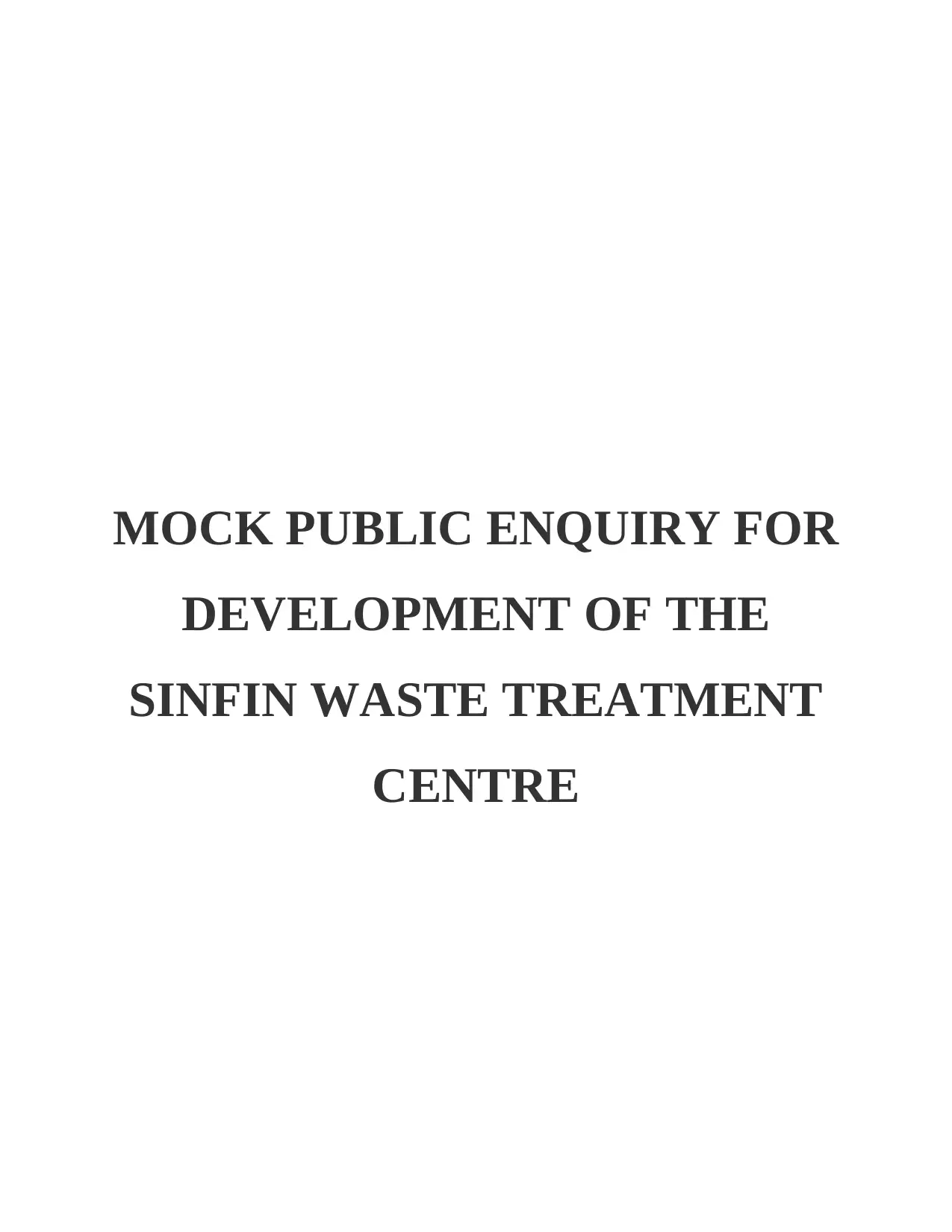
MOCK PUBLIC ENQUIRY FOR
DEVELOPMENT OF THE
SINFIN WASTE TREATMENT
CENTRE
DEVELOPMENT OF THE
SINFIN WASTE TREATMENT
CENTRE
Paraphrase This Document
Need a fresh take? Get an instant paraphrase of this document with our AI Paraphraser
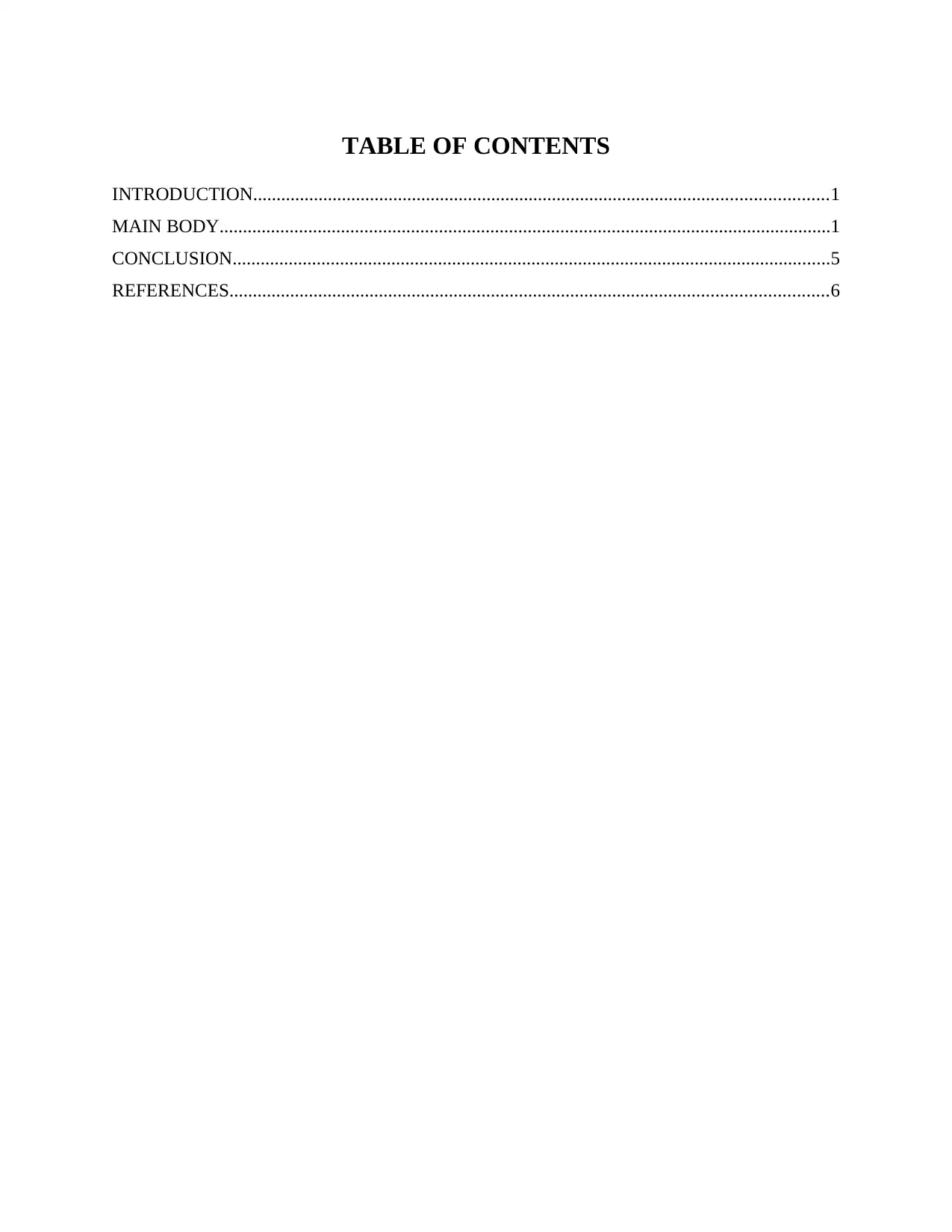
TABLE OF CONTENTS
INTRODUCTION...........................................................................................................................1
MAIN BODY...................................................................................................................................1
CONCLUSION................................................................................................................................5
REFERENCES................................................................................................................................6
INTRODUCTION...........................................................................................................................1
MAIN BODY...................................................................................................................................1
CONCLUSION................................................................................................................................5
REFERENCES................................................................................................................................6
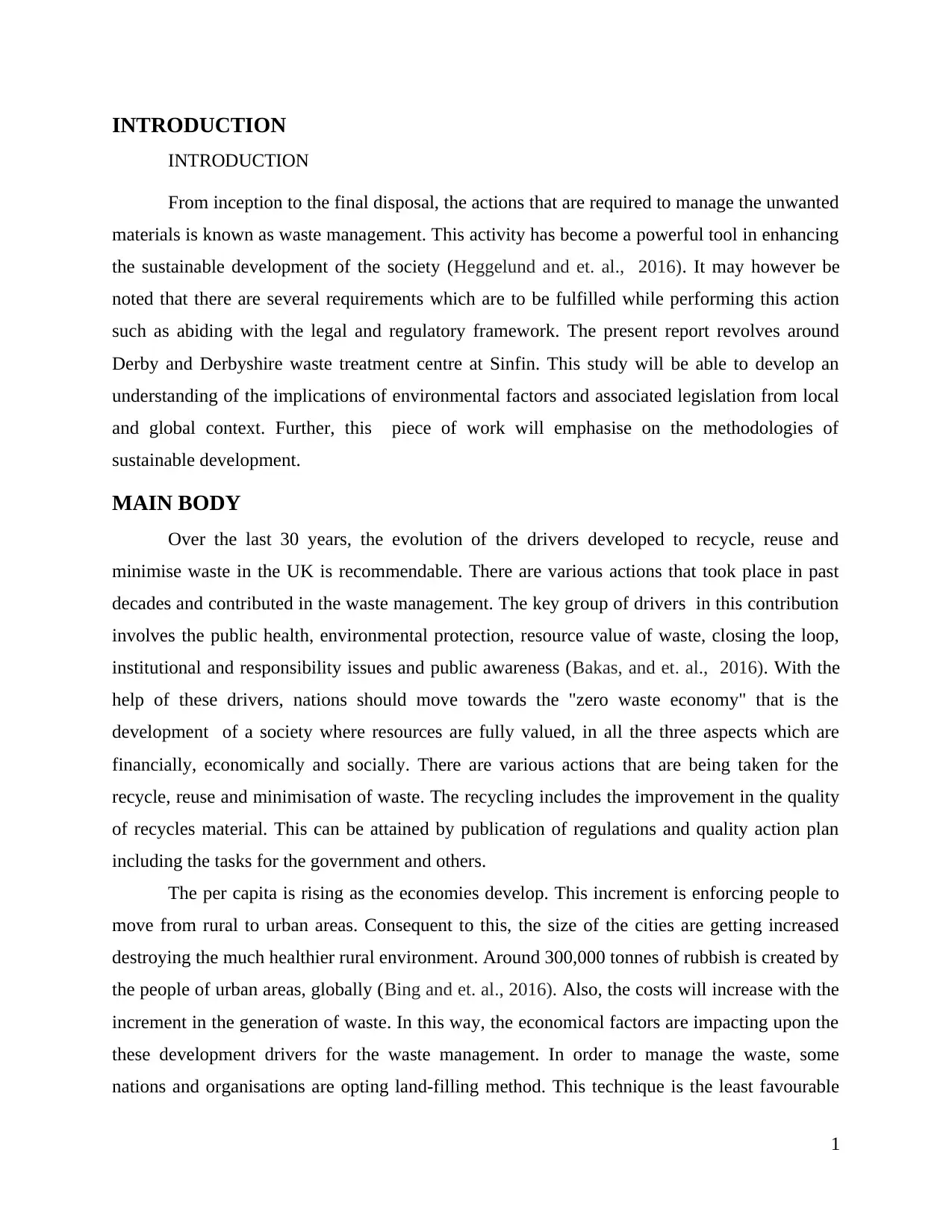
INTRODUCTION
INTRODUCTION
From inception to the final disposal, the actions that are required to manage the unwanted
materials is known as waste management. This activity has become a powerful tool in enhancing
the sustainable development of the society (Heggelund and et. al., 2016). It may however be
noted that there are several requirements which are to be fulfilled while performing this action
such as abiding with the legal and regulatory framework. The present report revolves around
Derby and Derbyshire waste treatment centre at Sinfin. This study will be able to develop an
understanding of the implications of environmental factors and associated legislation from local
and global context. Further, this piece of work will emphasise on the methodologies of
sustainable development.
MAIN BODY
Over the last 30 years, the evolution of the drivers developed to recycle, reuse and
minimise waste in the UK is recommendable. There are various actions that took place in past
decades and contributed in the waste management. The key group of drivers in this contribution
involves the public health, environmental protection, resource value of waste, closing the loop,
institutional and responsibility issues and public awareness (Bakas, and et. al., 2016). With the
help of these drivers, nations should move towards the "zero waste economy" that is the
development of a society where resources are fully valued, in all the three aspects which are
financially, economically and socially. There are various actions that are being taken for the
recycle, reuse and minimisation of waste. The recycling includes the improvement in the quality
of recycles material. This can be attained by publication of regulations and quality action plan
including the tasks for the government and others.
The per capita is rising as the economies develop. This increment is enforcing people to
move from rural to urban areas. Consequent to this, the size of the cities are getting increased
destroying the much healthier rural environment. Around 300,000 tonnes of rubbish is created by
the people of urban areas, globally (Bing and et. al., 2016). Also, the costs will increase with the
increment in the generation of waste. In this way, the economical factors are impacting upon the
these development drivers for the waste management. In order to manage the waste, some
nations and organisations are opting land-filling method. This technique is the least favourable
1
INTRODUCTION
From inception to the final disposal, the actions that are required to manage the unwanted
materials is known as waste management. This activity has become a powerful tool in enhancing
the sustainable development of the society (Heggelund and et. al., 2016). It may however be
noted that there are several requirements which are to be fulfilled while performing this action
such as abiding with the legal and regulatory framework. The present report revolves around
Derby and Derbyshire waste treatment centre at Sinfin. This study will be able to develop an
understanding of the implications of environmental factors and associated legislation from local
and global context. Further, this piece of work will emphasise on the methodologies of
sustainable development.
MAIN BODY
Over the last 30 years, the evolution of the drivers developed to recycle, reuse and
minimise waste in the UK is recommendable. There are various actions that took place in past
decades and contributed in the waste management. The key group of drivers in this contribution
involves the public health, environmental protection, resource value of waste, closing the loop,
institutional and responsibility issues and public awareness (Bakas, and et. al., 2016). With the
help of these drivers, nations should move towards the "zero waste economy" that is the
development of a society where resources are fully valued, in all the three aspects which are
financially, economically and socially. There are various actions that are being taken for the
recycle, reuse and minimisation of waste. The recycling includes the improvement in the quality
of recycles material. This can be attained by publication of regulations and quality action plan
including the tasks for the government and others.
The per capita is rising as the economies develop. This increment is enforcing people to
move from rural to urban areas. Consequent to this, the size of the cities are getting increased
destroying the much healthier rural environment. Around 300,000 tonnes of rubbish is created by
the people of urban areas, globally (Bing and et. al., 2016). Also, the costs will increase with the
increment in the generation of waste. In this way, the economical factors are impacting upon the
these development drivers for the waste management. In order to manage the waste, some
nations and organisations are opting land-filling method. This technique is the least favourable
1
⊘ This is a preview!⊘
Do you want full access?
Subscribe today to unlock all pages.

Trusted by 1+ million students worldwide
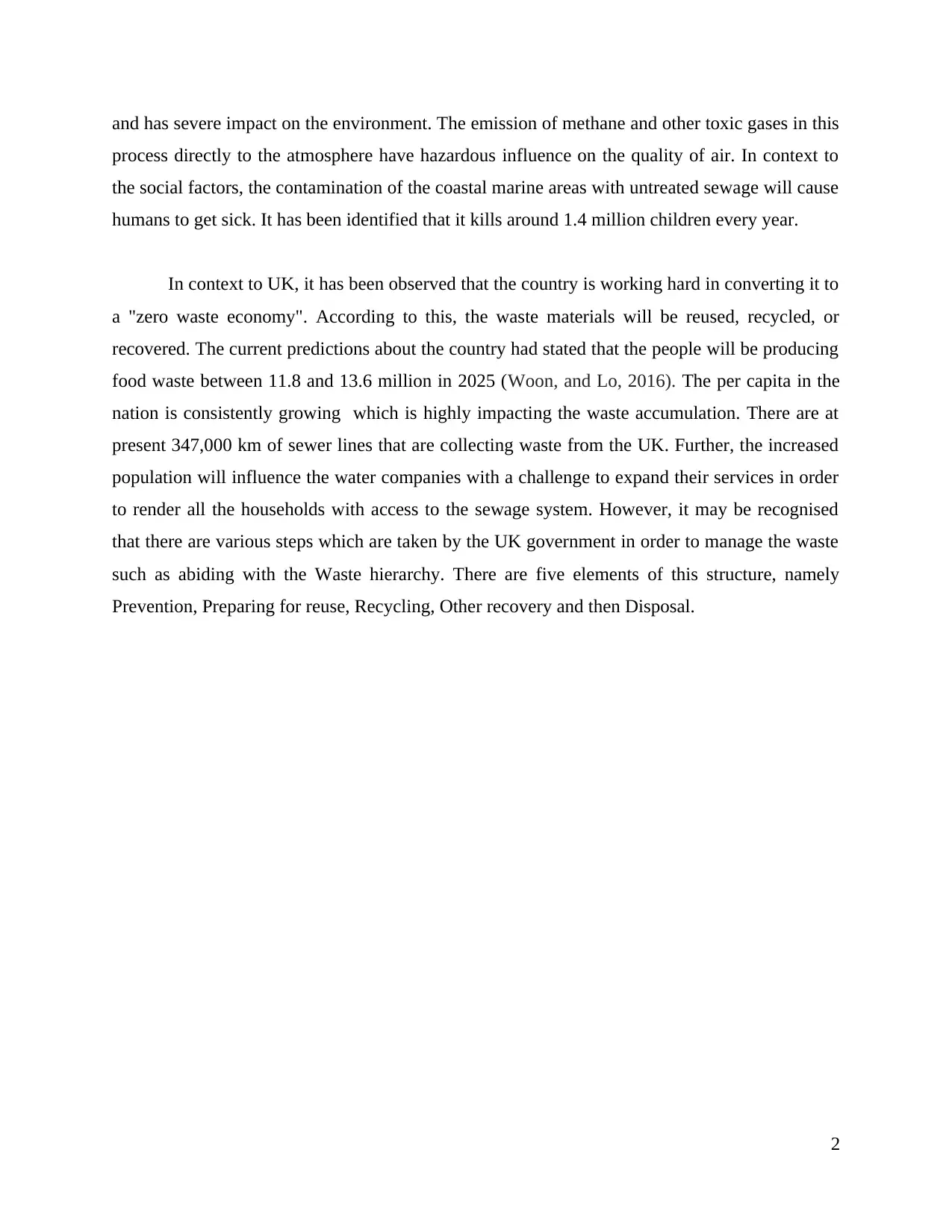
and has severe impact on the environment. The emission of methane and other toxic gases in this
process directly to the atmosphere have hazardous influence on the quality of air. In context to
the social factors, the contamination of the coastal marine areas with untreated sewage will cause
humans to get sick. It has been identified that it kills around 1.4 million children every year.
In context to UK, it has been observed that the country is working hard in converting it to
a "zero waste economy". According to this, the waste materials will be reused, recycled, or
recovered. The current predictions about the country had stated that the people will be producing
food waste between 11.8 and 13.6 million in 2025 (Woon, and Lo, 2016). The per capita in the
nation is consistently growing which is highly impacting the waste accumulation. There are at
present 347,000 km of sewer lines that are collecting waste from the UK. Further, the increased
population will influence the water companies with a challenge to expand their services in order
to render all the households with access to the sewage system. However, it may be recognised
that there are various steps which are taken by the UK government in order to manage the waste
such as abiding with the Waste hierarchy. There are five elements of this structure, namely
Prevention, Preparing for reuse, Recycling, Other recovery and then Disposal.
2
process directly to the atmosphere have hazardous influence on the quality of air. In context to
the social factors, the contamination of the coastal marine areas with untreated sewage will cause
humans to get sick. It has been identified that it kills around 1.4 million children every year.
In context to UK, it has been observed that the country is working hard in converting it to
a "zero waste economy". According to this, the waste materials will be reused, recycled, or
recovered. The current predictions about the country had stated that the people will be producing
food waste between 11.8 and 13.6 million in 2025 (Woon, and Lo, 2016). The per capita in the
nation is consistently growing which is highly impacting the waste accumulation. There are at
present 347,000 km of sewer lines that are collecting waste from the UK. Further, the increased
population will influence the water companies with a challenge to expand their services in order
to render all the households with access to the sewage system. However, it may be recognised
that there are various steps which are taken by the UK government in order to manage the waste
such as abiding with the Waste hierarchy. There are five elements of this structure, namely
Prevention, Preparing for reuse, Recycling, Other recovery and then Disposal.
2
Paraphrase This Document
Need a fresh take? Get an instant paraphrase of this document with our AI Paraphraser
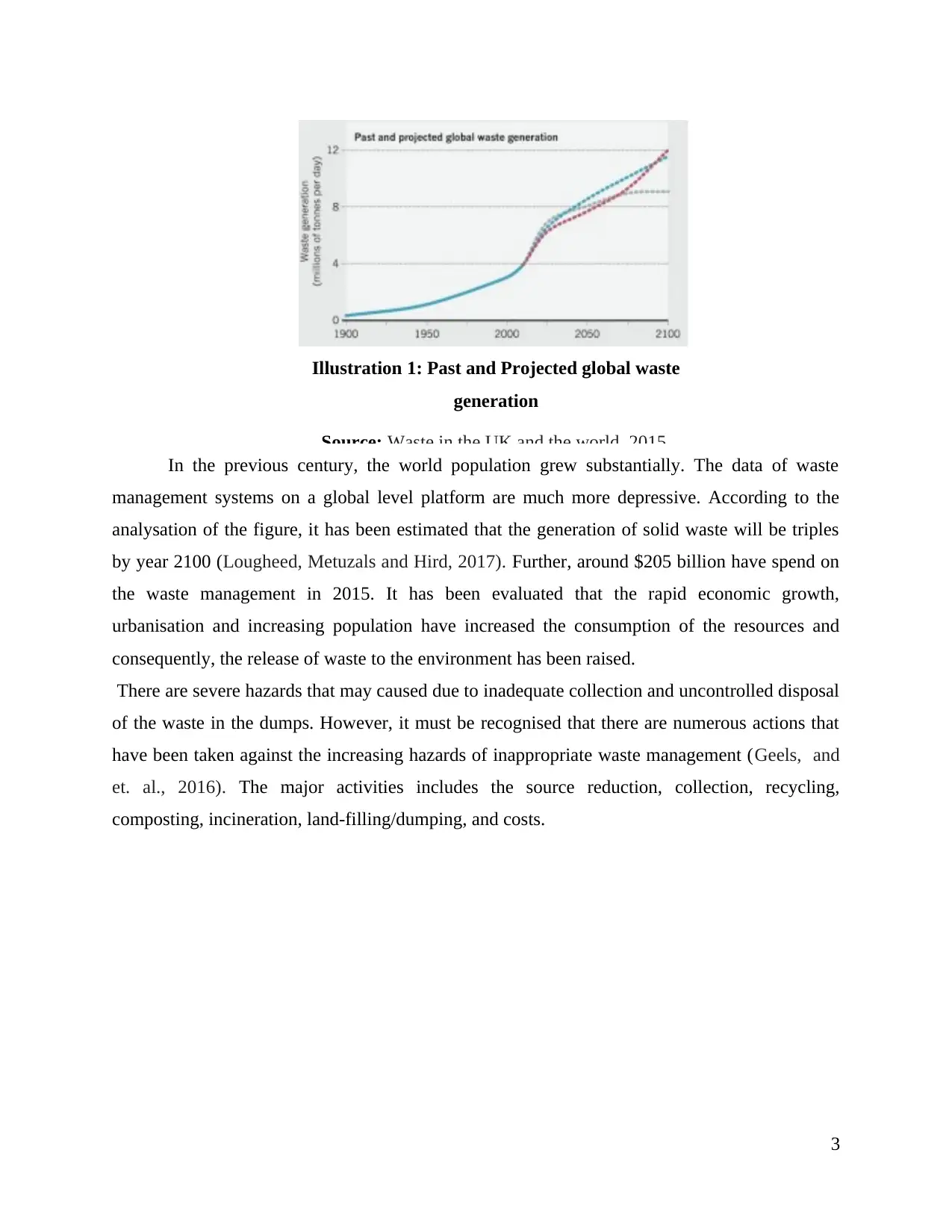
In the previous century, the world population grew substantially. The data of waste
management systems on a global level platform are much more depressive. According to the
analysation of the figure, it has been estimated that the generation of solid waste will be triples
by year 2100 (Lougheed, Metuzals and Hird, 2017). Further, around $205 billion have spend on
the waste management in 2015. It has been evaluated that the rapid economic growth,
urbanisation and increasing population have increased the consumption of the resources and
consequently, the release of waste to the environment has been raised.
There are severe hazards that may caused due to inadequate collection and uncontrolled disposal
of the waste in the dumps. However, it must be recognised that there are numerous actions that
have been taken against the increasing hazards of inappropriate waste management (Geels, and
et. al., 2016). The major activities includes the source reduction, collection, recycling,
composting, incineration, land-filling/dumping, and costs.
3
Illustration 1: Past and Projected global waste
generation
Source: Waste in the UK and the world, 2015.
management systems on a global level platform are much more depressive. According to the
analysation of the figure, it has been estimated that the generation of solid waste will be triples
by year 2100 (Lougheed, Metuzals and Hird, 2017). Further, around $205 billion have spend on
the waste management in 2015. It has been evaluated that the rapid economic growth,
urbanisation and increasing population have increased the consumption of the resources and
consequently, the release of waste to the environment has been raised.
There are severe hazards that may caused due to inadequate collection and uncontrolled disposal
of the waste in the dumps. However, it must be recognised that there are numerous actions that
have been taken against the increasing hazards of inappropriate waste management (Geels, and
et. al., 2016). The major activities includes the source reduction, collection, recycling,
composting, incineration, land-filling/dumping, and costs.
3
Illustration 1: Past and Projected global waste
generation
Source: Waste in the UK and the world, 2015.
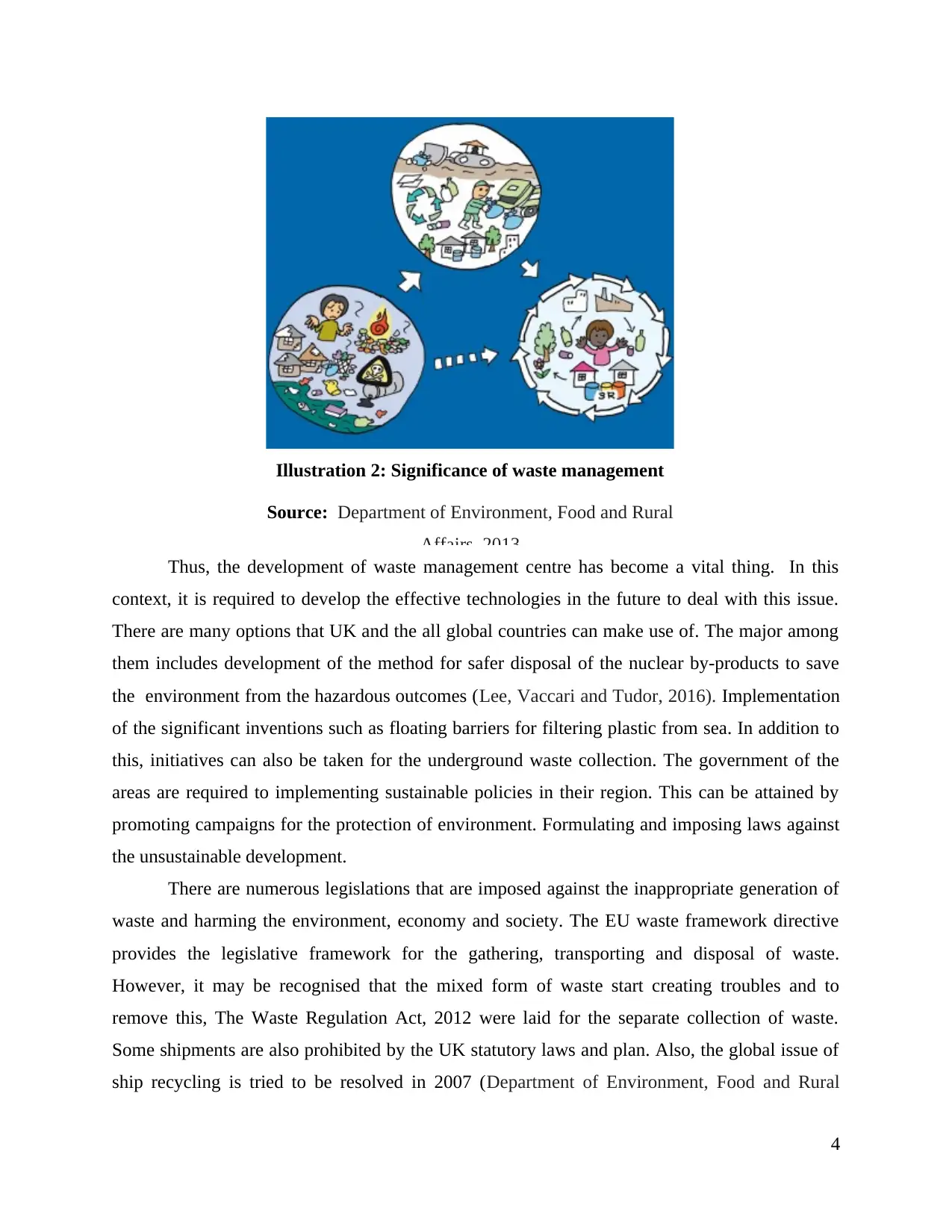
Thus, the development of waste management centre has become a vital thing. In this
context, it is required to develop the effective technologies in the future to deal with this issue.
There are many options that UK and the all global countries can make use of. The major among
them includes development of the method for safer disposal of the nuclear by-products to save
the environment from the hazardous outcomes (Lee, Vaccari and Tudor, 2016). Implementation
of the significant inventions such as floating barriers for filtering plastic from sea. In addition to
this, initiatives can also be taken for the underground waste collection. The government of the
areas are required to implementing sustainable policies in their region. This can be attained by
promoting campaigns for the protection of environment. Formulating and imposing laws against
the unsustainable development.
There are numerous legislations that are imposed against the inappropriate generation of
waste and harming the environment, economy and society. The EU waste framework directive
provides the legislative framework for the gathering, transporting and disposal of waste.
However, it may be recognised that the mixed form of waste start creating troubles and to
remove this, The Waste Regulation Act, 2012 were laid for the separate collection of waste.
Some shipments are also prohibited by the UK statutory laws and plan. Also, the global issue of
ship recycling is tried to be resolved in 2007 (Department of Environment, Food and Rural
4
Illustration 2: Significance of waste management
Source: Department of Environment, Food and Rural
Affairs, 2013
context, it is required to develop the effective technologies in the future to deal with this issue.
There are many options that UK and the all global countries can make use of. The major among
them includes development of the method for safer disposal of the nuclear by-products to save
the environment from the hazardous outcomes (Lee, Vaccari and Tudor, 2016). Implementation
of the significant inventions such as floating barriers for filtering plastic from sea. In addition to
this, initiatives can also be taken for the underground waste collection. The government of the
areas are required to implementing sustainable policies in their region. This can be attained by
promoting campaigns for the protection of environment. Formulating and imposing laws against
the unsustainable development.
There are numerous legislations that are imposed against the inappropriate generation of
waste and harming the environment, economy and society. The EU waste framework directive
provides the legislative framework for the gathering, transporting and disposal of waste.
However, it may be recognised that the mixed form of waste start creating troubles and to
remove this, The Waste Regulation Act, 2012 were laid for the separate collection of waste.
Some shipments are also prohibited by the UK statutory laws and plan. Also, the global issue of
ship recycling is tried to be resolved in 2007 (Department of Environment, Food and Rural
4
Illustration 2: Significance of waste management
Source: Department of Environment, Food and Rural
Affairs, 2013
⊘ This is a preview!⊘
Do you want full access?
Subscribe today to unlock all pages.

Trusted by 1+ million students worldwide
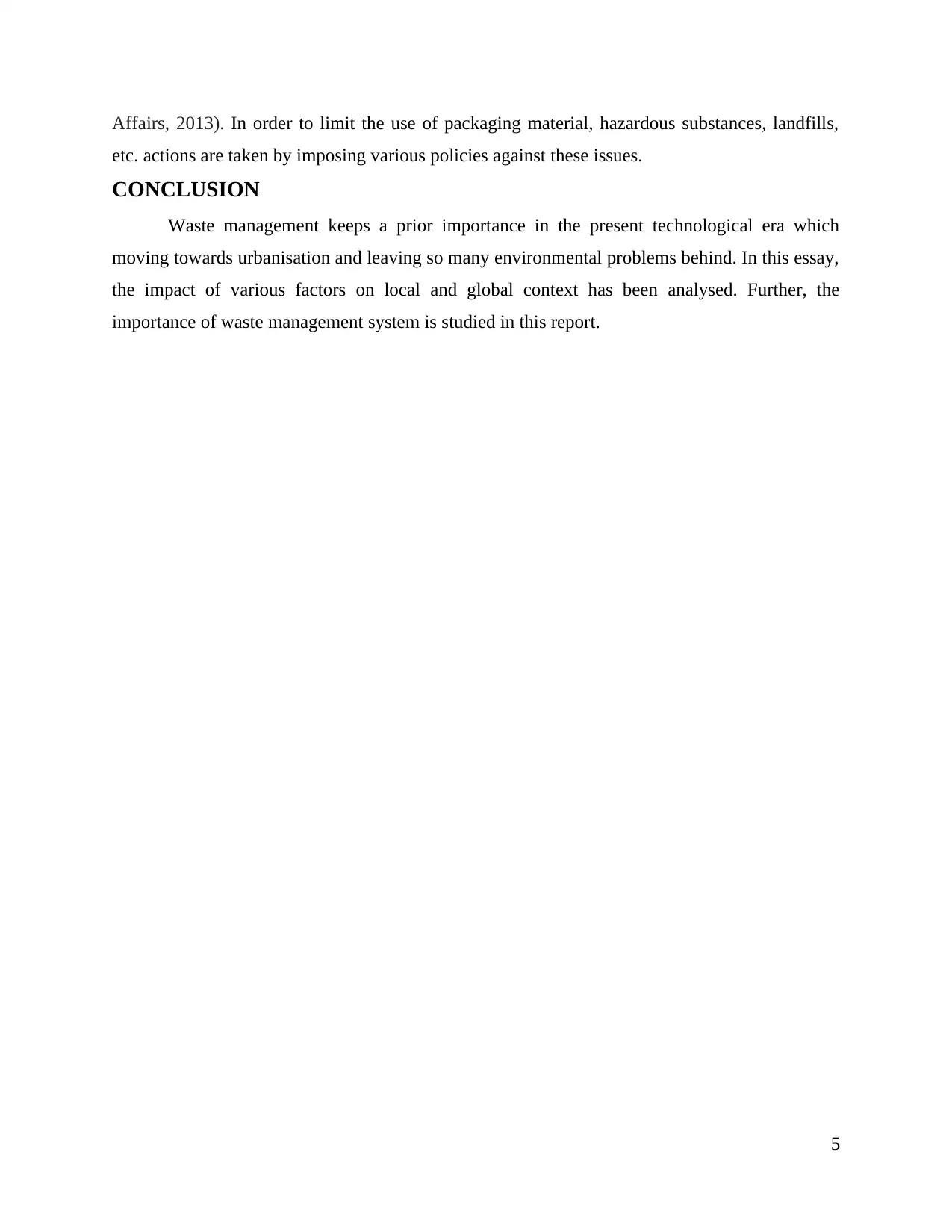
Affairs, 2013). In order to limit the use of packaging material, hazardous substances, landfills,
etc. actions are taken by imposing various policies against these issues.
CONCLUSION
Waste management keeps a prior importance in the present technological era which
moving towards urbanisation and leaving so many environmental problems behind. In this essay,
the impact of various factors on local and global context has been analysed. Further, the
importance of waste management system is studied in this report.
5
etc. actions are taken by imposing various policies against these issues.
CONCLUSION
Waste management keeps a prior importance in the present technological era which
moving towards urbanisation and leaving so many environmental problems behind. In this essay,
the impact of various factors on local and global context has been analysed. Further, the
importance of waste management system is studied in this report.
5
Paraphrase This Document
Need a fresh take? Get an instant paraphrase of this document with our AI Paraphraser
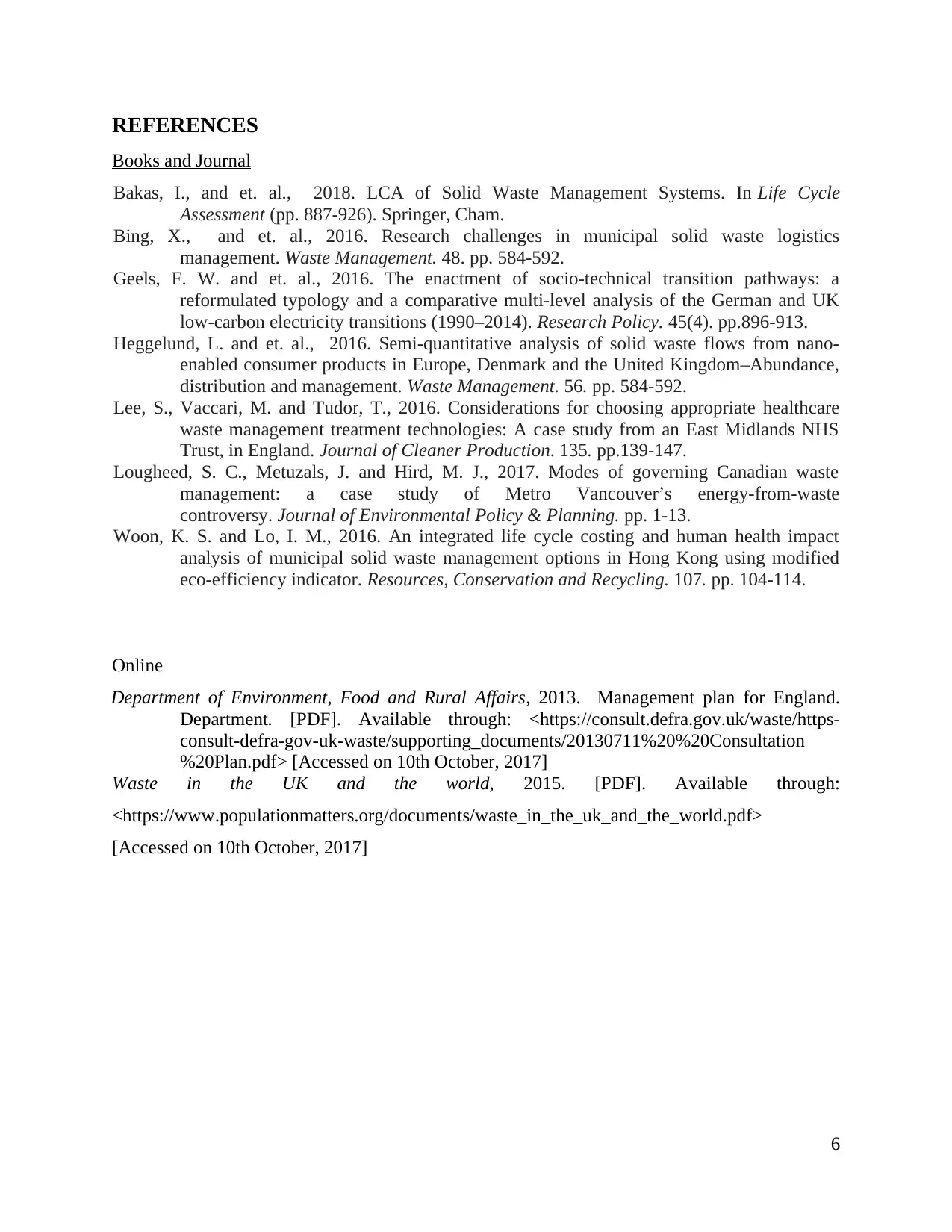
REFERENCES
Books and Journal
Bakas, I., and et. al., 2018. LCA of Solid Waste Management Systems. In Life Cycle
Assessment (pp. 887-926). Springer, Cham.
Bing, X., and et. al., 2016. Research challenges in municipal solid waste logistics
management. Waste Management. 48. pp. 584-592.
Geels, F. W. and et. al., 2016. The enactment of socio-technical transition pathways: a
reformulated typology and a comparative multi-level analysis of the German and UK
low-carbon electricity transitions (1990–2014). Research Policy. 45(4). pp.896-913.
Heggelund, L. and et. al., 2016. Semi-quantitative analysis of solid waste flows from nano-
enabled consumer products in Europe, Denmark and the United Kingdom–Abundance,
distribution and management. Waste Management. 56. pp. 584-592.
Lee, S., Vaccari, M. and Tudor, T., 2016. Considerations for choosing appropriate healthcare
waste management treatment technologies: A case study from an East Midlands NHS
Trust, in England. Journal of Cleaner Production. 135. pp.139-147.
Lougheed, S. C., Metuzals, J. and Hird, M. J., 2017. Modes of governing Canadian waste
management: a case study of Metro Vancouver’s energy-from-waste
controversy. Journal of Environmental Policy & Planning. pp. 1-13.
Woon, K. S. and Lo, I. M., 2016. An integrated life cycle costing and human health impact
analysis of municipal solid waste management options in Hong Kong using modified
eco-efficiency indicator. Resources, Conservation and Recycling. 107. pp. 104-114.
Online
Department of Environment, Food and Rural Affairs, 2013. Management plan for England.
Department. [PDF]. Available through: <https://consult.defra.gov.uk/waste/https-
consult-defra-gov-uk-waste/supporting_documents/20130711%20%20Consultation
%20Plan.pdf> [Accessed on 10th October, 2017]
Waste in the UK and the world, 2015. [PDF]. Available through:
<https://www.populationmatters.org/documents/waste_in_the_uk_and_the_world.pdf>
[Accessed on 10th October, 2017]
6
Books and Journal
Bakas, I., and et. al., 2018. LCA of Solid Waste Management Systems. In Life Cycle
Assessment (pp. 887-926). Springer, Cham.
Bing, X., and et. al., 2016. Research challenges in municipal solid waste logistics
management. Waste Management. 48. pp. 584-592.
Geels, F. W. and et. al., 2016. The enactment of socio-technical transition pathways: a
reformulated typology and a comparative multi-level analysis of the German and UK
low-carbon electricity transitions (1990–2014). Research Policy. 45(4). pp.896-913.
Heggelund, L. and et. al., 2016. Semi-quantitative analysis of solid waste flows from nano-
enabled consumer products in Europe, Denmark and the United Kingdom–Abundance,
distribution and management. Waste Management. 56. pp. 584-592.
Lee, S., Vaccari, M. and Tudor, T., 2016. Considerations for choosing appropriate healthcare
waste management treatment technologies: A case study from an East Midlands NHS
Trust, in England. Journal of Cleaner Production. 135. pp.139-147.
Lougheed, S. C., Metuzals, J. and Hird, M. J., 2017. Modes of governing Canadian waste
management: a case study of Metro Vancouver’s energy-from-waste
controversy. Journal of Environmental Policy & Planning. pp. 1-13.
Woon, K. S. and Lo, I. M., 2016. An integrated life cycle costing and human health impact
analysis of municipal solid waste management options in Hong Kong using modified
eco-efficiency indicator. Resources, Conservation and Recycling. 107. pp. 104-114.
Online
Department of Environment, Food and Rural Affairs, 2013. Management plan for England.
Department. [PDF]. Available through: <https://consult.defra.gov.uk/waste/https-
consult-defra-gov-uk-waste/supporting_documents/20130711%20%20Consultation
%20Plan.pdf> [Accessed on 10th October, 2017]
Waste in the UK and the world, 2015. [PDF]. Available through:
<https://www.populationmatters.org/documents/waste_in_the_uk_and_the_world.pdf>
[Accessed on 10th October, 2017]
6
1 out of 8
Related Documents
Your All-in-One AI-Powered Toolkit for Academic Success.
+13062052269
info@desklib.com
Available 24*7 on WhatsApp / Email
![[object Object]](/_next/static/media/star-bottom.7253800d.svg)
Unlock your academic potential
Copyright © 2020–2025 A2Z Services. All Rights Reserved. Developed and managed by ZUCOL.





